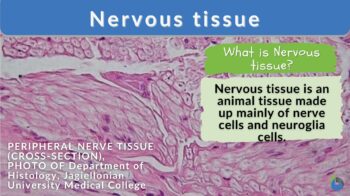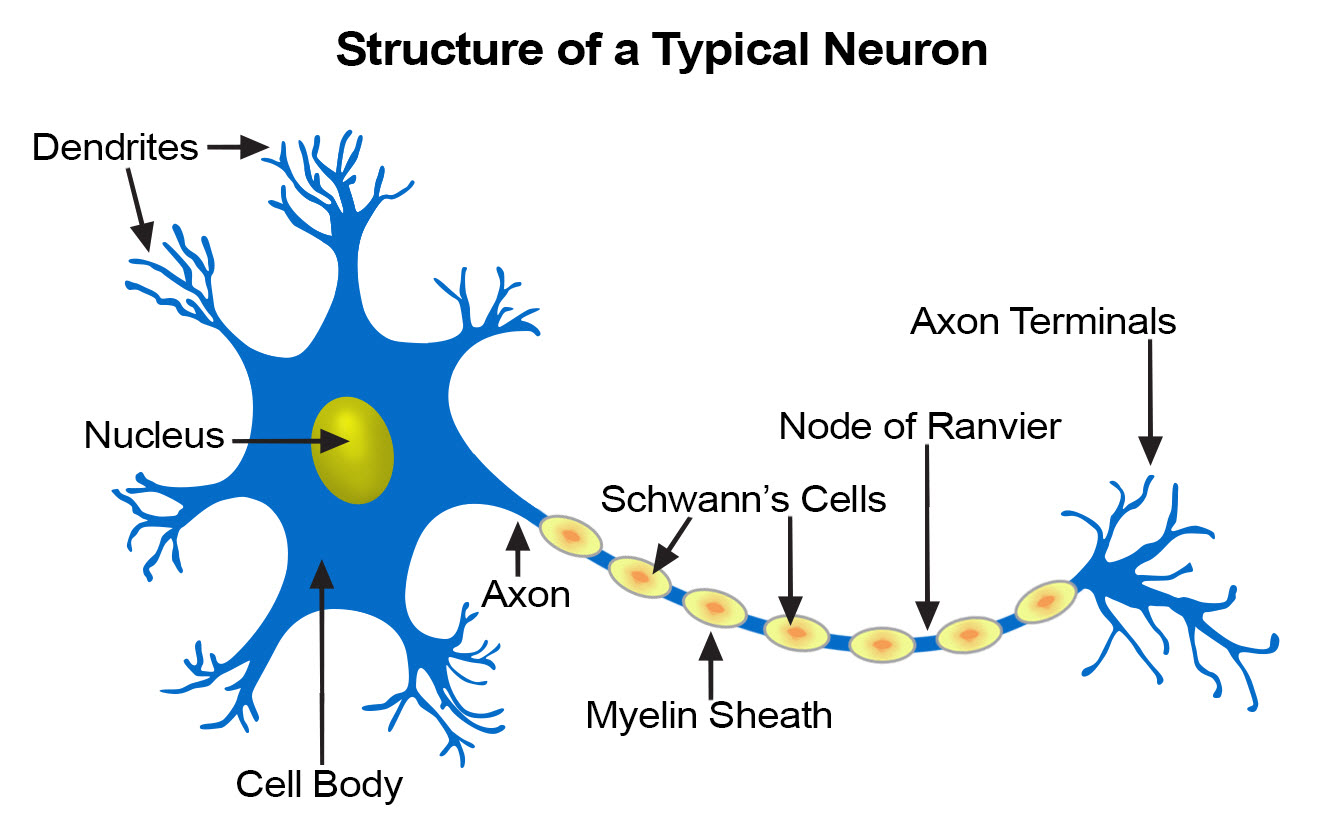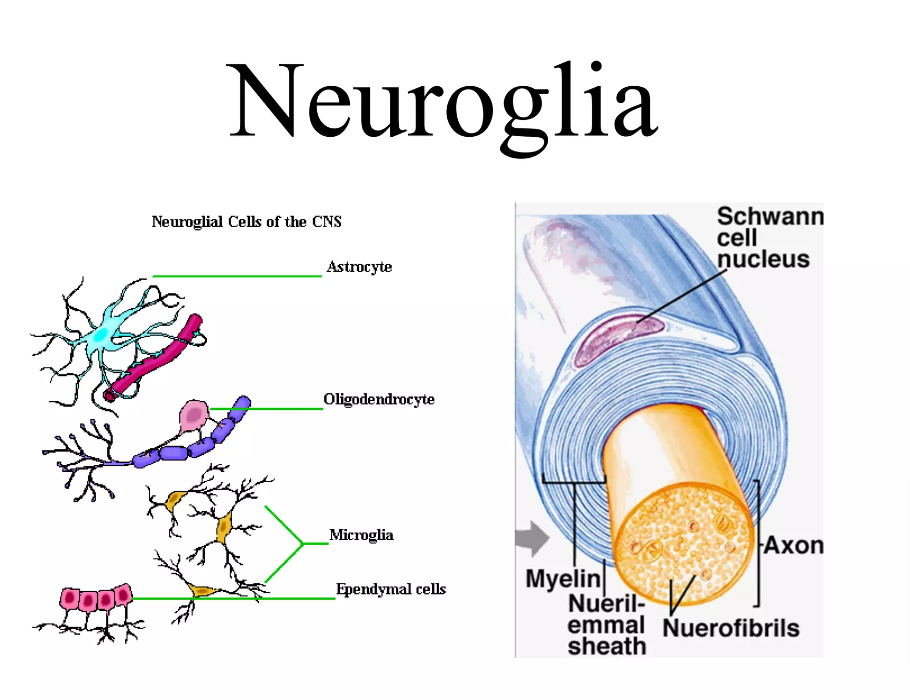
Nervous tissue
n., plural: nervous tissues
[ˈnɜːvəs ˈtɪʃu]
Definition: animal tissuemade up mainly of nerve cells and neuroglia cells of the nervous system.
Table of Contents
Nervous Tissue Definition
Nerve cells (or neurons) and their associated cells, such as neuroglia cells, make up nervous tissue. Nerve cells are specialized cells responsible for receiving and transmitting nerve impulses or action potentials from one nerve cell to the next. Dendrites and axons are two types of cellular projections found in nerve cells.
Living creatures’ structural and functional units are cells. They execute fundamental bodily functions. A group of these specialized cells works together to produce tissue. Animals and plants have various tissues. There are four types of tissues in animals which include muscular, epithelial, connective tissue, and nervous tissue.
Nerves, the spinal cord, and the brain all include nervous tissue. Many bodily functions are coordinated and under its direction. It stimulates muscular contraction, increases environmental awareness, and is essential for emotions, memory, and thought.
To conduct all of these duties, cells in nervous tissue must be able to communicate with one another via electrical nerve impulses. Neurons, also known as nerve cells, are the cells in the nervous system that generate and conduct impulses. The dendrites, the cell body, and the axon are the three main structural components of these cells.
The cell body is the primary component of the cell and performs all of its fundamental tasks. Dendrites are cytoplasmic processes that carry impulses to the cell body. The axon is a mechanism or extension that transfers impulses from the cell body. The axon forms synaptic connections that run through the neurons. The synaptic connections are a neural net’s learned information is contained inside the interconnections between its neurons.
Additionally, nerve tissue contains cells that support the functions of the neurons rather than transmit impulses. These are the neuroglia, also known as glial cells (neuroglial cells). The neurons are connected and insulated by glia, or supporting cells. Some glial cells are capable of immune protection by being phagocytic; others serve as conduits that deliver nutrition as they bind the blood vessels to the neurons.
The nervous tissue is a type of animal tissue comprised principally of nerve cells and neuroglia cells. It is one of the major types of animal tissues, the others are epithelial tissue, muscular tissue, and connective tissue. The nerve cells are specialized cells that receive and transmit nerve impulses or action potentials from one nerve cell to the next. The nerve cells have characteristic cellular projections (dendrites that receive the electrochemical signals from another nerve cell and axons that convey the action potential to the next nerve cell). The neuroglia cells aid in protecting and providing nutrients to the nerve cells. They also help maintain homeostasis and form myelin.
Structure
Neurons, commonly known as nerve cells, and neuroglial cells make up nervous tissue. Astrocytes, microglial cells, ependymal cells, and oligodendrocytes are the four different forms of neuroglia that can be found in the central nervous system (CNS). The entire Schwann cells and satellite cells are two varieties of neuroglia that are present in the peripheral nervous system (PNS). The autonomic nervous system is a peripheral nervous system component that controls involuntary physiologic functions such as heart rate and many other things.
The somatic nervous system is another component of the peripheral nervous system that is connected with the voluntary regulation of body motions via skeletal muscles. Grey matter and white matter are the two tissue types that can be found in the CNS. The tissue’s neuronal and neuroglial components are used to classify it.
The parasympathetic nervous system (PNS) is one of the autonomic nervous system’s (ANS) two functionally different and continuously active divisions. It works in opposition to the sympathetic nervous system (SNS).
In calm “rest and digest” situations, the parasympathetic nervous system predominates, whereas the sympathetic nervous system drives the “fight or flight” reaction in stressful situations. The primary function of the PNS is to save energy for later use and to control body activities such as digestion and urine.
The sympathetic nervous system consists of a network of nerves associated with activating the body’s “fight-or-flight” response. This system gets more active when you are anxious, in danger, or physically involved. Its effects include increased heart rate and respiratory capacity, improved eyesight, and a slowdown of functions such as digestion.
The enteric nervous system (ENS) is a component of the peripheral nervous system (PNS) that can regulate gastrointestinal behavior without the need for input from the central nervous system (CNS). Mammalian neurons can be found in the CNS (brain and spinal cord) or the PNS (cells with soma outside the brain and spinal cord).
The blood-brain barrier (BBB) is an important immunological component of the human central nervous system (CNS). The dendrite blood-brain barrier, which is made up of many different cell types, serves as a structural and functional barrier to pathogens such as bacteria, fungi, viruses, and parasites that may be circulating in the bloodstream.
The central nervous system (CNS) requires a number of amino acids contained in protein diets to function properly. The brain uses amino acids including tryptophan, tyrosine, histidine, and arginine to synthesize different neurotransmitters and neuromodulators.
Nervous Tissue Location
The peripheral nervous system (PNS), which is made up of branching peripheral nerves, and the central nervous system (CNS), which is made up of the spinal cord and the brain, are the two major components of the nervous tissue that control and regulate the body’s functions and activities.
The cerebrospinal fluid (CSF) is a clear, colorless, watery fluid circulating around your brain and spinal cord. The CNS is made up of the brain and spinal cord. It controls and coordinates everything you do, such as your ability to move and breathe.
The central nervous system organs like the brain and spinal cord as well as the peripheral nerve throughout the body contain nervous tissue. Neurons, or nerve cells, make up the nervous tissue. Axons, which are elongated projections that protrude from the cell body of neurons, are how these specialized cells respond to stimuli by sending out messages. This is done through signaling molecules.
Signaling molecules have crucial roles in the nervous tissue. However, sometimes there are excess signaling molecules and the body must go through the process of removing excess signaling molecules.
Nervous Tissue Diagram
Below is a diagram of each one of the types of nervous tissue, a neuron, and a neuroglia.


The Function of Nervous Tissue
By carrying electric signals through tissue, nervous tissue serves as the nervous system’s network of communication. Grey matter, which houses the synapses in the CNS, is crucial for processing information. Between grey matter regions in the CNS, white matter with myelinated axons connects and promotes nerve impulses. Unmyelinated axons will not perform this function. The myelin sheath is a type of connective tissue covering.
Relay locations for nerve tissue impulses are found in the ganglion tissue of the PNS, which also contains cell bodies and dendrites. Bundles of myelinated axons carry action potential nerve impulses fiber bundles and axons in the nervous tissue.
Types of Nervous Tissue Cells
The two main types of cells predominant in the nervous tissue present in organisms are neurons and neuroglia.
Neurons
Neurons are specialized cells that may receive and promote the transmission of nerve impulses, or action potentials, across their membrane to the following neuron. They have an axon, dendrites, and a big cell body (soma), which house the cell projections.
Thin branching projections called dendrites receive electrochemical communication from neurotransmitters to alter the cell’s voltage. The action potential is carried by lengthy extensions called axons from the cell body to the next neuron.
A small space known as a synaptic cleft divides the bulb-shaped end of the axon, or the axon terminal, from the dendrite of the neuron after it. Neurotransmitters are released across the synapse and attach to the post-synaptic receptors at the axon terminal, continuing the nerve impulse.
Both functional and structural classifications are used for the different types of neurons.
Functional category:
- Afferent sensory neurons: transmit sensory data from the PNS to the CNS as an action potential (nerve impulse)
- Interneurons: cells in the brain or spinal cord that link neurons and whose activities are confined to a specific geographical region
- Efferent motor neurons: Action potentials should be relayed from the CNS to the appropriate effector (muscles, glands). Note how nervous tissues comprising of sensory or motor neurons have different functions.
Classification of structures:
- Solitary brush cells: are glutamatergic excitatory interneurons with a single short dendrite that terminates in a tuft of dendrioles like a brush. These are located in the cerebellum’s granular layer.
- Three or more processes protrude from the soma (cell body) of multipolar neurons. They make up the majority of the CNS’s neuron population and contain both interneurons and motor neurons.
- Sensory cells known as “bipolar neurons” have two processes—a dendrite and an axon—that emerge from the soma. Sensory neurons known as pseudounipolar neurons contain a single process that divides into two branches to generate the axon and dendrite.
Parts of a neuron:
As you taught in the first section, the cell body, also known as the soma, is the most important portion of a neuron. The nucleus and the majority of the main organelles are found in the cell body. But what distinguishes neurons is that they contain numerous extensions of their cell membranes known as processes.
Axons, which are nerve fibers that emerge from the cell body and project to target cells, are generally seen in neurons. A single axon can branch repeatedly in order to communicate with a large number of target cells. The axon is responsible for transmitting the nerve impulse to one or more cells.
Dendrites, which receive information from neighboring neurons via specific areas of contact known as synapses, are the neuron’s other operations. Dendrites are typically heavily branching processes that allow other neurons to interface with the cell body.
From the dendrites to the cell body and down the axon, information passes via a neuron. This gives the neuron polarity, which means that information only flows in one direction.
Shapes of neurons:
Multiple processes emerge from the cell bodies of multipolar neurons (thus the name). They have dendrites linked to their cell bodies and, in certain cases, a single lengthy axon. Many CNS neurons, including motor neurons, are multipolar.
Two opposing processes (bipolar cells) extend from each end of the cell body in bipolar cells. The first is an axon, and the second is a dendrite. Bipolar cells are extremely rare. They are mostly present in the olfactory epithelium (where scent stimuli are detected) and as a component of the retina in the eye.

Neuroglia
The non-neural cells in nerve tissue known as neuroglia (or glial cells) serve a variety of vital supportive roles for neurons. They differ in structure depending on their function and are smaller than neurons.
The glial cell membrane closely wraps around the glial cell layers to create the structure of the glial cell membrane which is branched. It is a tightly wrapped plasma membrane. This makes their shape like a spiral (or as said above, branches), similar to that of the immune system’s multipolar shape.
The choroid plexus specialized structure is lined with ependyma, a type of specialized epithelial tissue. Ependymal cells are ciliated simple columnar glial cells that line the ventricles (central cavity within the brain that is filled with CSF) and central canal of the spinal cord.
The following categories apply to neuroglial cells:
- The basic immune system of the central nervous system comprises macrophage cells called microglial cells. They are the tiniest type of neuroglial cell.
- Astrocytes are the CNS’s star-shaped cells, which have several processes. They are the most prevalent type of cell in the brain and essential to a healthy central nervous system.
- CNS cells with very few processes are called oligodendrocytes. The axons of a neuron develop myelin sheaths, which are lipid-based insulation that speeds up the action potential’s descent through the axon.
- NG2 glia are CNS cells that are unique from microglia, oligodendrocytes, and astrocytes and act as oligodendrocytes’ developmental progenitors.
- The PNS analogue of oligodendrocytes and entire Schwann cells surrounds and supports the preservation of axons and the formation of myelin sheaths.
- Ganglia, which are collections of nerve body cells bundled or joined together in the PNS, contain satellite glial cells that line the surface of neuron cell bodies or cell bodies.
- Glia called enteric are located in the gastrointestinal tract’s enteric nervous system.
Examples of Nervous Tissues in the Human Body
In the CNS, examples of nervous tissues are grey matter and white matter. Both grey matter and white matter contain neurons. However, the arrangement of the neurons in these tissues results in a distinctive division of color post-mortem. As their name implies, grey matter is grayish (pinkish tan, if in a living brain) whereas white matter is ‘white’. In grey matter, the predominant part is the cell body of the neuron whereas, in white matter, the predominant part is the myelinated axon. The axons usually occur as bundles — of which are referred to as “tracts” in the CNS (called “nerves”, if in the PNS).
Aside from the cell bodies of the neurons, grey matter also has the following: capillaries, glial cells (microglia and astrocytes), dendrites, neuropils, and yes, a few axon tracts. White matter, in turn, contains unmyelinated axons and glial cells (oligodendrocytes and astrocytes).
In the brain’s cerebrum and cerebellum, grey matter is located outside surrounding white matter that is located in the inside region. However, in the spinal cord, grey matter is located towards the inner region whereas white matter is on the outside.
In the PNS, the nervous tissues are the nerves and the ganglion.
Note it! What does a nervous tissue do?
The nervous tissue’s primary job is to receive inputs and send information to the brain and spinal cord. The nerves carry these signals to the muscles.
Watch this vid about nervous tissue:
Take the Nervous Tissue – Biology Quiz!
Further Reading
References
- Akinrodoye, M. A., & Lui, F. (2023). Neuroanatomy, Somatic Nervous System. In StatPearls. StatPearls Publishing. http://www.ncbi.nlm.nih.gov/books/NBK556027/
- Biga, L. M., Dawson, S., Harwell, A., Hopkins, R., Kaufmann, J., LeMaster, M., Matern, P., Morrison-Graham, K., Quick, D., & Runyeon, J. (2019). 12.2 Nervous Tissue. https://open.oregonstate.education/aandp/chapter/12-2-nervous-tissue/
- Brodal, P. (2010). The Central Nervous System. Oxford University Press.
Michael Wrock. (06:47:46 UTC). Neuroglia. https://www.slideshare.net/Firedemon13/neuroglia-9190918 - Nerve Tissue | SEER Training. (n.d.). Retrieved April 18, 2023, from https://training.seer.cancer.gov/anatomy/nervous/tissue.html
- Nervous Tissue | SEER Training. (n.d.). Retrieved April 18, 2023, from https://training.seer.cancer.gov/anatomy/cells_tissues_membranes/tissues/nervous.html
- Nervous Tissue—Characteristics, Structure, Function. (2020, September 13). BYJUS. https://byjus.com/biology/nervous-tissue/
- OpenStaxCollege. (2013). Nervous Tissue. https://pressbooks-dev.oer.hawaii.edu/anatomyandphysiology/chapter/nervous-tissue/
- Peripheral Nervous System | histology. (n.d.). Retrieved April 18, 2023, from https://histology.medicine.umich.edu/resources/peripheral-nervous-system
- Tindle, J., & Tadi, P. (2023). Neuroanatomy, Parasympathetic Nervous System. In StatPearls. StatPearls Publishing. http://www.ncbi.nlm.nih.gov/books/NBK553141/
- (N.d.). Retrieved April 18, 2023, from https://web.archive.org/web/20160612143125/http://classic.sidwell.edu/us/science/vlb7/tissuelab/results/nervous.html
- Mackenzie, R. J. (2019, August 20). Gray Matter vs White Matter. Neuroscience from Technology Networks; Technology Networks. https://www.technologynetworks.com/neuroscience/articles/gray-matter-vs-white-matter-322973
©BiologyOnline.com. Content provided and moderated by Biology Online Editors.







